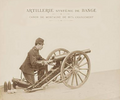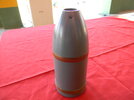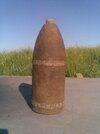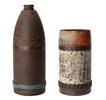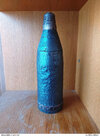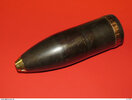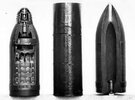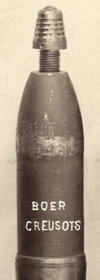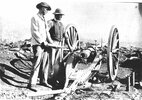frijoles108
Well-Known Member
Hello Guys,
I got this projectile recently thinking I was going to be getting a 3.2 inch American projectile, but when it arrived the in person evaluation of it is puzzling. It is certainly not a 3.2 inch, as the diameter the base of it is 3.0940 inches (using dial caliper to remeasure multiple times with same result). This translates to about 78mm with some change, which was certainly not what I had expected. Checking 3.2 inch projectile diameters in archived documents shows they would have had a diameter of 3.15 at the very least, making me doubt it is that. Other odd features to me include its interior cavity (which i can't show a picture of as its too dark). When I looked inside with a light I noted that it is not a flat or recessed flat bottom as I would expect for a shrapnel shell of this early time period. However, it has a rounded interior and curved base, making me think it is more likely to have had a explosive charge. Black powder charge maybe? The ogive is odd as well, as its too narrow for any American fuzes I know of from the pre 1900 time period, and appears to more likely have taken a French "beehive" pattern fuze. I do know that the United States utilized copies of beehive fuzes on their shells, but the projectile's size matches no gun I can find that feasibly would have fired it in the U.S. inventory (when looking in old archive documentation). The only U.S. gun of 3.1" was a Civil war Confederate gun, which is simply too old to have been firing this pattern of projectile. The only other potential small lead I have is finding 3.1 inch guns listed among captured Boer guns by the British during the 2nd Boer war. However, I couldn't find much more information on this as it was mentioned briefly in a british source. When searching for photos of captured Boer projectiles, in general, I did notice that some projectiles (although different sizes from mine) did share somewhat of a similar profile in addition to taking french pattern "beehive" fuzes. Information on Boer artillery though seems rather sparse, so I was hoping someone here could help me to shed some light on this projectile (or point me in the correct direction). Also, the maker mark is odd. It appears to be shaped like an ace of spades, and then the letters SJ. Opposite of these marks are what appears to be another lightly stamped ace of spades (sorry this is only way i could think to describe it).
One thing I did note however, is its condition tells me that it had been picked up by someone almost immediately after being fired as it has ZERO pitting on it. Or it was in a very very arid environment.
Dimensions: 3.0940 inches in diameter, 8.5 inches in height almost exactly.
(Feel free to shoot down my idea of it being Boer maybe if you have any good ideas)
(also sorry ahead of time, I am trying to rotate the photos upright, they were upright when I uploaded them)







I got this projectile recently thinking I was going to be getting a 3.2 inch American projectile, but when it arrived the in person evaluation of it is puzzling. It is certainly not a 3.2 inch, as the diameter the base of it is 3.0940 inches (using dial caliper to remeasure multiple times with same result). This translates to about 78mm with some change, which was certainly not what I had expected. Checking 3.2 inch projectile diameters in archived documents shows they would have had a diameter of 3.15 at the very least, making me doubt it is that. Other odd features to me include its interior cavity (which i can't show a picture of as its too dark). When I looked inside with a light I noted that it is not a flat or recessed flat bottom as I would expect for a shrapnel shell of this early time period. However, it has a rounded interior and curved base, making me think it is more likely to have had a explosive charge. Black powder charge maybe? The ogive is odd as well, as its too narrow for any American fuzes I know of from the pre 1900 time period, and appears to more likely have taken a French "beehive" pattern fuze. I do know that the United States utilized copies of beehive fuzes on their shells, but the projectile's size matches no gun I can find that feasibly would have fired it in the U.S. inventory (when looking in old archive documentation). The only U.S. gun of 3.1" was a Civil war Confederate gun, which is simply too old to have been firing this pattern of projectile. The only other potential small lead I have is finding 3.1 inch guns listed among captured Boer guns by the British during the 2nd Boer war. However, I couldn't find much more information on this as it was mentioned briefly in a british source. When searching for photos of captured Boer projectiles, in general, I did notice that some projectiles (although different sizes from mine) did share somewhat of a similar profile in addition to taking french pattern "beehive" fuzes. Information on Boer artillery though seems rather sparse, so I was hoping someone here could help me to shed some light on this projectile (or point me in the correct direction). Also, the maker mark is odd. It appears to be shaped like an ace of spades, and then the letters SJ. Opposite of these marks are what appears to be another lightly stamped ace of spades (sorry this is only way i could think to describe it).
One thing I did note however, is its condition tells me that it had been picked up by someone almost immediately after being fired as it has ZERO pitting on it. Or it was in a very very arid environment.
Dimensions: 3.0940 inches in diameter, 8.5 inches in height almost exactly.
(Feel free to shoot down my idea of it being Boer maybe if you have any good ideas)
(also sorry ahead of time, I am trying to rotate the photos upright, they were upright when I uploaded them)









